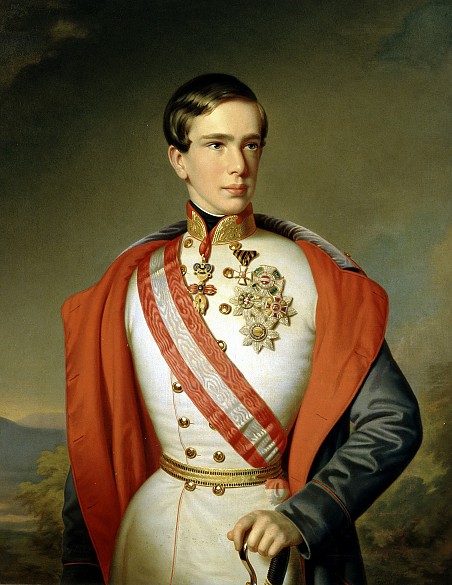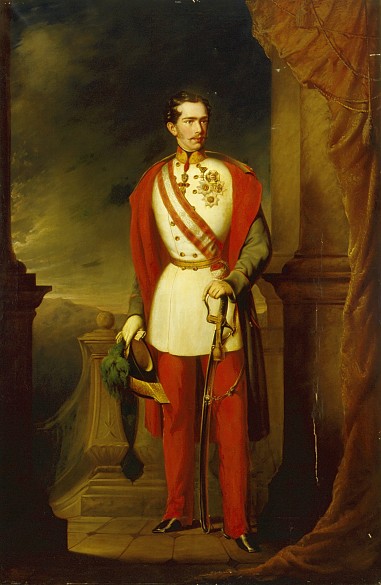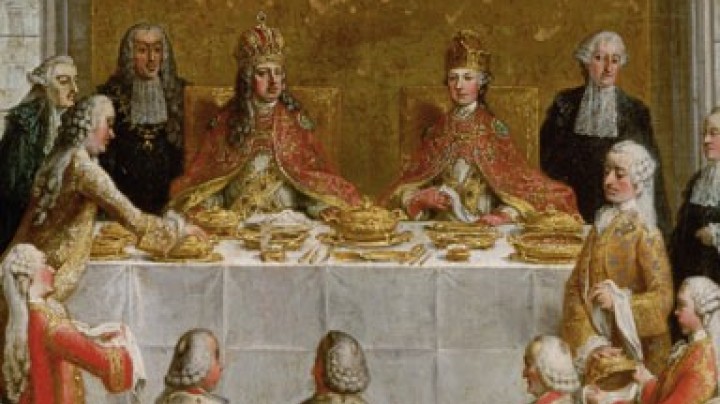Franz Joseph’s portrait
The monarch’s portrait was omnipresent in the Habsburg Empire – even in the farthest-flung corners of the monarchy it hung in schools and public offices, seeking to hold together what was inexorably drifting apart.
Joseph Roth: The Radetzky March, translated by Michael Hofmann, London 2003, 185.The District Commissioner [Trotta] was lunching in the station restaurant, at the table of the Jäger officers. … He sat at the long, horseshoe-shaped table, the only civilian there apart from Count Chojnicki, in the company of the brightly-clad officers, dark and lean, under the mural of Franz Joseph I, showing the familiar, universally circulated portrait of the Supreme Commander-in-Chief in his snow-white field-marshal’s tunic and crimson sash. Just a foot below the Emperor’s white whiskers and almost aligned with them, were the dark, barely greying wings of Trotta’s whiskers. The junior officers, sitting at the two ends of the horseshoe, detected the resemblance between His Apostolic Majesty and his servant. From where he was sitting, Lieutenant Trotta could also compare the Emperor’s face with that of his father. And for a few brief seconds the Lieutenant had the impression that the portrait on the wall was that of his somewhat aged father, while the man actually sitting at the table was a slightly younger version of the Emperor in civilian clothes. And Emperor and Father alike grew strange and distant to him.
Commissioning an official state portrait was one of the first acts of a newly-enthroned monarch. The purpose of these portraits was to create a physical presence for the ruler and to make his image omnipresent. Replicas of the official portrait hung everywhere state power was intended to be present: in foreign residences and nobles’ palaces, in embassies, ministries, public offices, in Parliament, in town halls and public institutions such as museums, theatres, military barracks, schools, universities …
The type of the schematized ruler’s portrait arose at the French court during the eighteenth century and spread throughout Europe. The portrait of the absolutist ruler followed a set pattern which prescribed the pose of the ruler and the inclusion of a column, draped curtain and a grandiose table together with the insignia of power. These rules continued to influence portraits of rulers painted in later ages.
Emperor Franz Joseph was also immortalized in this fashion. He believed he ruled by divine right and pursued an absolutist claim to power. In keeping with his soldierly upbringing and his faith in the army as one of the pillars of the throne, portraits of Emperor Franz Joseph in uniform outnumber all other kinds. For over sixty years, his portraits served the same purpose: the assurance that the monarch was omnipresent and guaranteed the continued existence of the Monarchy in perpetuity. Only his appearance changed as he aged – the beard grew white, the hairline receded. In contrast to the enthroned portrait of Emperor Franz II (I) by Friedrich Amerling, however, the physical decay of the monarch was not emphasized. His ageing was employed as a means of glorifying the ruler who was to hold together the empire in which cracks were appearing.
A special element in the iconography of Emperor Franz Joseph is his portrayal in outdoor settings: against majestic mountain backdrops, by lakes, in the forests, and time and again as a sportsman. In this way hunting costume became socially acceptable and the ruler depicted as a man of the people.
Rulers also started fashion trends with their state portraits – many a civil servant sported Franz Joseph’s mutton-chop whiskers, and Empress Elisabeth was a fashion icon during her own lifetime.























